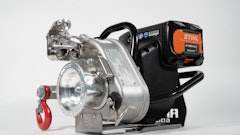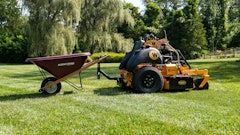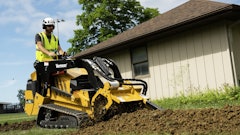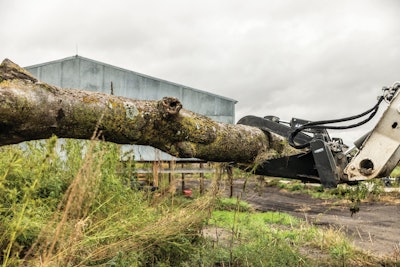
Tree removal can be a time-consuming process—especially when dealing with a mix of brush, small trees, and mature stumps across a property. Whether you're managing overgrown acreage, prepping a site, or clearing fence lines, the right attachment can turn a labor-intensive job into a much more efficient one.
There’s no one-size-fits-all solution. The best tool depends on what needs to be removed, how clean the finish should be and how much surface disruption is acceptable. Some jobs require precision, others call for power—and most operators want a method that minimizes rework and leaves the site ready for what’s next.
Here’s a look at five essential attachments for tree removal, including how they work, where they perform best and what to consider before putting them to use.
Tree Puller
Tree pullers are designed to remove smaller trees, shrubs and fence posts—roots and all—using hydraulic clamping jaws. Once secured, the tree is lifted vertically, extracting the root system in one pass. This is ideal for clearing invasive species, tidying up tree rows or removing fencing without leaving behind stumps.
Look for models that include a forward-positioned push bar. Optional post-pulling adapters can add versatility to fencing jobs.
In terms of limitations, most tree pullers max out at trunks around 8 inches in diameter. Soil disruption is another factor to consider—they remove roots entirely but may require some backfill and grading post-removal.
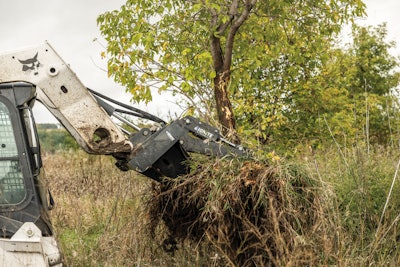 Ignite Attachments
Ignite Attachments
Stump Bucket
Where a tree puller lifts from the base, a stump bucket digs below. These narrow, curved buckets are designed to wedge under large stumps and apply focused breakout force to pry them loose. Serrated edges or reinforced points improve penetration, while compact depth maximizes machine efficiency.
The best options use high-grade steel, protective hose sleeves and reinforced gussets to handle repeated impact. Smart engineering can also improve the power-to-weight ratio—allowing operators to remove more without overloading the carrier.
Stump buckets excel at deep root removal and are often used in land development or site prep. But they’re not the fastest option. They also disturb more soil than surface-level tools, making them a less attractive choice for residential yards or decorative landscapes.
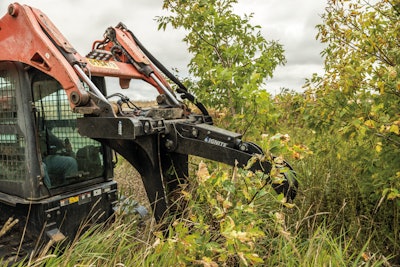 Ignite Attachments
Ignite Attachments
Grapple
If there’s one attachment that belongs on every compact loader, it might be the grapple. These hydraulically operated jaws are ideal for lifting, securing, and transporting everything from branches and logs to pulled stumps and scrap material.
Rake and root grapples are common for tree removal. Their open-bottom design lets soil fall through while retaining debris. Some models taper tine depth from front to back to aid breakout force, while others offer dual independent jaws to secure uneven loads.
When selecting a grapple, look for features that improve uptime and longevity—like greaseable pins, cylinder protection, laser-cut components and flat-faced couplers that connect under pressure. These not only reduce downtime but extend service life in high-impact applications.
While grapples handle cleanup well, they’re not made for prying or digging. Trying to do so can damage tines or overtax the machine. For deeper work, pair with a stump bucket or tree puller.
| More on Attachments from GreenIndustryPros.com |
| Equip Expo 2024 Q+A: Ignite Attachments - Jared Medhus, sales manager at Ignite Attachments, discusses what’s trending with contractors, green industry outlook and more. |
| Skid-steer Attachments Let You Work Smarter Not Harder - Few types of equipment represent more opportunity for increased jobsite productivity and safety than skid-steer attachments. |
| Seven Steps to Keep Skid-Steer Attachments Pumping Out Profits - The hydraulic systems of skid steers and compact track loaders must run at maximum efficiency when you work with many attachments. |
| Avoid a Mismatch Between Skid Steers/CTLs & Attachments - Universal skid-steer couplers can lead to loader compatibility mismatches. Here's how to avoid them. |
Mulcher
Mulchers, also called forestry mulchers or forestry heads, handle small trees and brush by grinding them into fine material at high speed. Ideal for clearing trails, reducing fire hazards or opening overgrown parcels, they excel in above-ground vegetation management. Forestry mulchers are heavy-duty attachments with a drum-style cutting head designed to mulch trees, thick brush, and dense undergrowth into fine chips. They typically require higher hydraulic flow and are built for demanding land clearing or right-of-way maintenance.
Because mulchers leave material on-site as mulch, there’s no need to haul debris—a time- and cost-saver in many settings. This also improves erosion control and can help suppress regrowth.
Operators should match the attachment to their machine’s hydraulic flow and pressure specs. Undersized carriers may struggle to maintain cutting speed, especially in dense material. Models with replaceable teeth, adjustable skid shoes, and protective shielding offer better durability and safer operation.
The key limitation? Mulchers leave the roots behind. For full removal, follow up with a stump-specific tool.
Rotary Cutter
Rotary cutters, sometimes called brush cutters or brush mowers, are brush-clearing attachments that mow through saplings, tall grass and woody undergrowth with spinning horizontal blades. They’re best for maintenance across large areas and can cut material up to about 1 inch thick, depending on model.
They’re faster than mulchers and great for covering ground. But rotary cutters don’t shred material as finely and won’t handle large trees. Rocks, stumps and debris can also pose a hazard—so cutters with reinforced decks, stump jumpers and safety chains are worth considering.
Use rotary cutters when you need to tame overgrowth but not remove it completely. They’re great for follow-up passes once larger material has been pulled or mulched.
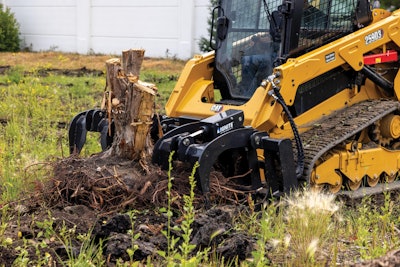 Ignite Attachments
Ignite Attachments
The Root of the Matter
Effective tree removal depends on matching the attachment to both the task and the terrain. Whether you're uprooting entire trees, grinding down brush, or cleaning up debris, selecting the right tool ensures faster work, better results, and less wear on your machine.
But it's not just about the application—it’s also about compatibility. The best-performing attachment won’t do much good if it overloads your carrier or doesn’t align with its hydraulic capacity. Take time to understand your equipment’s specifications and the demands of your job.
Working with your attachment manufacturer or using reliable online tools can help you make the right choice. Resources like compatibility checkers and spec-based selection guides make it easier to find an attachment that fits your machine, supports your workflow, and helps you get the job done right the first time.

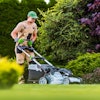
![Doosan Bobcat Wacker Neuson Stack 2ec Js Pb V6e[1]](https://img.greenindustrypros.com/mindful/acbm/workspaces/default/uploads/2025/12/doosan-bobcat-wacker-neuson-stack2ecjspbv6e1.CPyyz8ubHn.png?auto=format%2Ccompress&bg=fff&fill-color=fff&fit=fill&h=100&q=70&w=100)
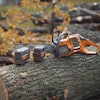

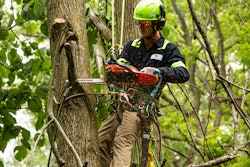
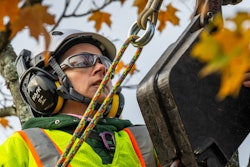


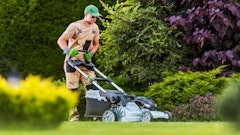
![Doosan Bobcat Wacker Neuson Stack 2ec Js Pb V6e[1]](https://img.greenindustrypros.com/mindful/acbm/workspaces/default/uploads/2025/12/doosan-bobcat-wacker-neuson-stack2ecjspbv6e1.CPyyz8ubHn.png?ar=16%3A9&auto=format%2Ccompress&bg=fff&fill-color=fff&fit=fill&h=135&q=70&w=240)
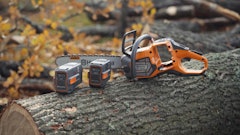
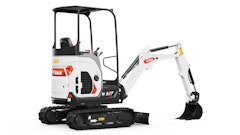
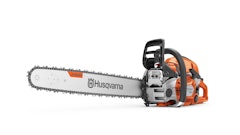
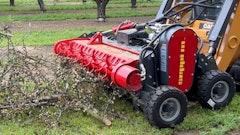
![T708 2025 Ga Tl11 R3 Hr [1 Q5 A1066]](https://img.greenindustrypros.com/mindful/acbm/workspaces/default/uploads/2025/10/t708-2025-ga-tl11r3-hr-1q5a1066.KcuUhTiF78.jpg?ar=16%3A9&auto=format%2Ccompress&fit=crop&h=135&q=70&w=240)
